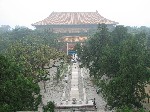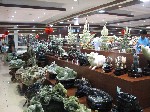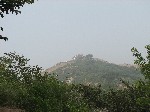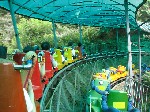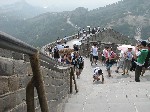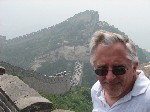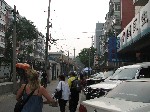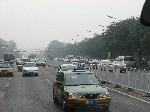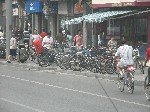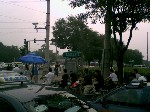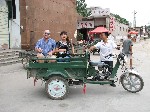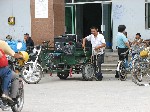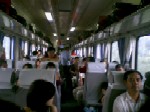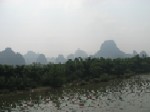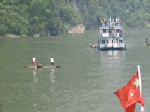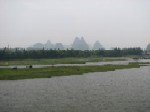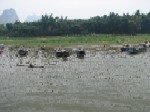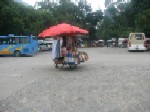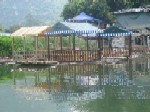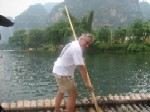
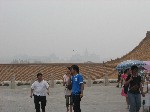 After a good night's rest and a breakfast of eggs and bacon/ham, we headed off for the Forbidden City, which is in the middle of Beijing. Since our hotel is only a mile or so, we walked. Along the way I took this photo of a typical city center street in Beijing. Once inside the Forbidden City I took this photo looking back into Beijing. Note the smog. It's bad, but not as bad as I've seen in Southern California.
After a good night's rest and a breakfast of eggs and bacon/ham, we headed off for the Forbidden City, which is in the middle of Beijing. Since our hotel is only a mile or so, we walked. Along the way I took this photo of a typical city center street in Beijing. Once inside the Forbidden City I took this photo looking back into Beijing. Note the smog. It's bad, but not as bad as I've seen in Southern California.
|
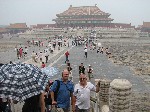
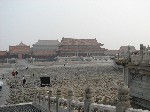 The Forbidden City was the Chinese imperial palace from the mid-Ming Dynasty to the Qing Dynasty. It was built from 1406 to 1420 and parts of it had to be rebuilt as they burned down due to lightning. There is 980 surviving buildings (and we walked through half of them - wew!) Here's Tim and I inside the Forbidden City and a picture of another courtyard. It really is like a small city - big!
The Forbidden City was the Chinese imperial palace from the mid-Ming Dynasty to the Qing Dynasty. It was built from 1406 to 1420 and parts of it had to be rebuilt as they burned down due to lightning. There is 980 surviving buildings (and we walked through half of them - wew!) Here's Tim and I inside the Forbidden City and a picture of another courtyard. It really is like a small city - big!
|
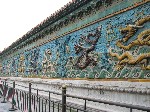
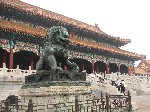 Here's a picture of the 9-dragon wall and the entrance to one of the many structures in the Forbidden City.
Here's a picture of the 9-dragon wall and the entrance to one of the many structures in the Forbidden City.
|
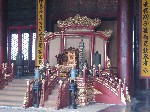
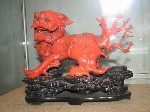 Here's a picture of one of the many thrones in the Forbidden City and a picture of one of the many pieces of artwork (a dragon carved from red coral).
Here's a picture of one of the many thrones in the Forbidden City and a picture of one of the many pieces of artwork (a dragon carved from red coral).
|
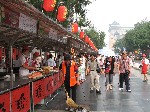
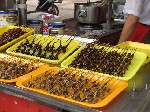 After a long day of exploring the Forbidden City we headed back to the hotel. Along the way we found this 1/4 block long "street food" market. They had everything that Beijing had to offer to eat. I have to admit there were a lot of things that looked good to eat and I was getting hungry. However, the beetles and scorpions on a stick killed my appetite. Then the ostrich head (sans eyes and feathers) I found and the smell of some unknown “food” cooking was it. I had to head for the "exit". I think I will play it safe tonight and have noodles :)
After a long day of exploring the Forbidden City we headed back to the hotel. Along the way we found this 1/4 block long "street food" market. They had everything that Beijing had to offer to eat. I have to admit there were a lot of things that looked good to eat and I was getting hungry. However, the beetles and scorpions on a stick killed my appetite. Then the ostrich head (sans eyes and feathers) I found and the smell of some unknown “food” cooking was it. I had to head for the "exit". I think I will play it safe tonight and have noodles :)
|
|
For dinner we ventured out and found a rather expensive Chinese restaurant (no noodles - darn). The food was good, but flavored differently than any of us expected. After the main course we were given complimentary deserts (which was nice, since it was Tricia’s birthday) – sugar water and shredded green beans. Yum, yum. Who wants cake and ice cream on their birthday when you can have sugar water and shredded green beans?
|
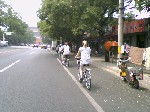
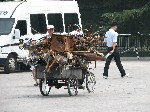 We started off the day by packing and checking out as we head to Xi’an tonight. Once checked out of our hotel we decide to tour Beijing by rented bikes (when in Rome…). Bicycles are definitely a good way to get around Beijing - if you don’t mind playing "chicken" with buses. Speaking of bicycles, here is a bike (tricycle) than many people use to haul “stuff” around with. We’ve seen everything from junk to crates of food to a stack of house windows on these.
We started off the day by packing and checking out as we head to Xi’an tonight. Once checked out of our hotel we decide to tour Beijing by rented bikes (when in Rome…). Bicycles are definitely a good way to get around Beijing - if you don’t mind playing "chicken" with buses. Speaking of bicycles, here is a bike (tricycle) than many people use to haul “stuff” around with. We’ve seen everything from junk to crates of food to a stack of house windows on these.
|
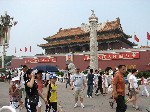
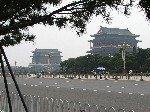 We peddled our way back to the Forbidden City and across the street to Tiananmen Square. Tiananmen Square is named after the Tiananmen (Gate of Heavenly Peace) Gate which is just north of the square. Also the square separates the gate from the Forbidden City (all of these are in the center of Beijing). Here are picture of Tim in front of the Forbidden City entrance and the Tiananmen Gate.
We peddled our way back to the Forbidden City and across the street to Tiananmen Square. Tiananmen Square is named after the Tiananmen (Gate of Heavenly Peace) Gate which is just north of the square. Also the square separates the gate from the Forbidden City (all of these are in the center of Beijing). Here are picture of Tim in front of the Forbidden City entrance and the Tiananmen Gate.
|
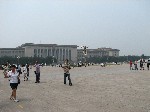
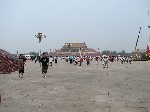 Here some more photos of Tiananmen Square (Great Hall of the People, Forbidden City, Mao Zedong Mausoleum, and soldiers marching).
Here some more photos of Tiananmen Square (Great Hall of the People, Forbidden City, Mao Zedong Mausoleum, and soldiers marching).
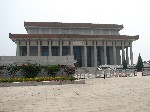
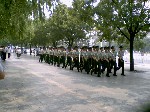
|

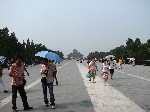 From Tiananmen Square we peddled to the Temple of Heaven, which was built from 1406 to 1420 by the Ming dynasty. The Emperors of the Ming and Qing dynasties would visit the temple for annual ceremonies of prayer to Heaven for good harvest. The first picture is of the Hall of Prayer for Good Harvests, while the second is looking from the Imperial Vault of Heaven to the Hall of Prayer for Good Harvests. The third picture is looking from the Hall of Prayer for Good Harvests towards the Beijing skyline.
From Tiananmen Square we peddled to the Temple of Heaven, which was built from 1406 to 1420 by the Ming dynasty. The Emperors of the Ming and Qing dynasties would visit the temple for annual ceremonies of prayer to Heaven for good harvest. The first picture is of the Hall of Prayer for Good Harvests, while the second is looking from the Imperial Vault of Heaven to the Hall of Prayer for Good Harvests. The third picture is looking from the Hall of Prayer for Good Harvests towards the Beijing skyline.
|
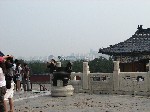
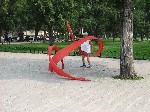 Finally, there must have been some kind of holiday as many people were in the temple grounds conducting various activities (Hmmm, Saturday in the temple grounds. Wasn’t that a Doobie Brothers’ song?). Anyway, here is a man with his Chinese ribbon, a short video of people dancing and a short video of people playing music (all at the Temple of Heaven).
Finally, there must have been some kind of holiday as many people were in the temple grounds conducting various activities (Hmmm, Saturday in the temple grounds. Wasn’t that a Doobie Brothers’ song?). Anyway, here is a man with his Chinese ribbon, a short video of people dancing and a short video of people playing music (all at the Temple of Heaven).
|
|
|
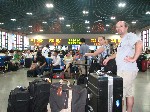 After we returned the bikes we meet with Rick Brown and had a late lunch. From there we headed to the Beijing West train station (trains are a popular form of transportation here and the train station was big and very busy).
After we returned the bikes we meet with Rick Brown and had a late lunch. From there we headed to the Beijing West train station (trains are a popular form of transportation here and the train station was big and very busy).
|
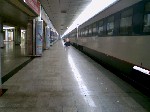
 Here is the train we took and my cabin (which I shared with 3 Chinese). Unfortunately, due to the slow tourist season there was no dining car and no bar car (ie little to eat on the train, there was a porter selling warm drinks and dry noodles and hot water was available, however). Fortunately, there was a tour group in our car from the Netherlands who were in a party mood and who had plenty of snacks to share. Other than the fact that the beds on the train were VERY uncomfortable, traveling by train proved as affordable and as convenient as by air. By biggest fear now is that Xi’an will be has hot and humid as Beijing was.
Here is the train we took and my cabin (which I shared with 3 Chinese). Unfortunately, due to the slow tourist season there was no dining car and no bar car (ie little to eat on the train, there was a porter selling warm drinks and dry noodles and hot water was available, however). Fortunately, there was a tour group in our car from the Netherlands who were in a party mood and who had plenty of snacks to share. Other than the fact that the beds on the train were VERY uncomfortable, traveling by train proved as affordable and as convenient as by air. By biggest fear now is that Xi’an will be has hot and humid as Beijing was.
|
|
We spent most of the day "off-loading" from the train (dragging that luggage on and off the train was a real hassle/workout) getting ourselves fed, showered, and rested. We also meet with Senlin Chen, an instructor at the Shaanxi Normal University. Prior to our expedition, Senlin graciously offered his help in getting us a place to stay at the Shaanxi Normal University hotel in Xi’an. Tomorrow we start looking for a good webcast location (power, Internet, and pollution-free skies – the smog looks real bad here in Xi’an). In the meantime, we will venture out to into the streets of Xi’an.
|
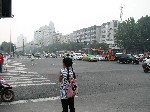
 We went for a walk in Xi’an to orient ourselves and to do some recon. Here is a photo of the area near the university we are at and a photo of a common mode of family transportation. A trailer for the luggage and they are set to go on vacation.
We went for a walk in Xi’an to orient ourselves and to do some recon. Here is a photo of the area near the university we are at and a photo of a common mode of family transportation. A trailer for the luggage and they are set to go on vacation.
|
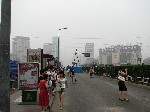 As far as the weather goes it does not appear to be as hot as Beijing, but it is much more humid and the air quality stinks (cough, cough, eyes burn, must not rub eyes....). See for yourself. Those buildings in the distance (the ones you can barely see, the ones behind the stuff in the middle of the road) are less than a half-mile away and the 1362.00 foot tall Xi'an TV tower is only a few miles away and should be easily visible down this road, but it is not. As John Wayne would say, "That's not fog pilgrim.".
As far as the weather goes it does not appear to be as hot as Beijing, but it is much more humid and the air quality stinks (cough, cough, eyes burn, must not rub eyes....). See for yourself. Those buildings in the distance (the ones you can barely see, the ones behind the stuff in the middle of the road) are less than a half-mile away and the 1362.00 foot tall Xi'an TV tower is only a few miles away and should be easily visible down this road, but it is not. As John Wayne would say, "That's not fog pilgrim.".
|
|
Our current hotel is at the south end of Xi’an, where the eclipse will not be “total,” we headed off to look at a hotel that is on the north end of town (Xi’an is also a big city – 3.9 million) where the eclipse will be “total”. The hotel looks good and has a much better Internet connection than we currently have. However, since the hotel is still in the city (air pollution) we will also visit Weinan, China which is 39 miles from Xi’an. However, the chances of finding a hotel with a good Internet connection may be slim there.
|

 Today the air is significantly cleaner and you can even see that BIG TV tower at the south end of town. Speaking of air quality, you hardly need solar glasses to look at the Sun here due to the polution. Here's the evening sun without any filters - sure is pretty.
Today the air is significantly cleaner and you can even see that BIG TV tower at the south end of town. Speaking of air quality, you hardly need solar glasses to look at the Sun here due to the polution. Here's the evening sun without any filters - sure is pretty.
|

 We are staying at the University hotel which is near the Big Wild Goose Pagoda, so we walked over to see it. The Pagoda was built in 652 AD and is a holy place for Buddhists. It was originally intended as a place to hold Buddhist materials that were taken from India by the hierarch Xuanzang who traveled along the Silk Road (which starts here in Xi’an) to India. Here’s a picture of us in front of the Pagoda’s entrance and a picture of one of the monks who appear to live here. Finally, while visiting the Pagoda, we ran into (of all people) Fred Espenak (http://www.mreclipse.com/) of NASA’s Goddard Space Flight Center. We only had a few minutes to introduce ourselves, but it was nice to meet him.
We are staying at the University hotel which is near the Big Wild Goose Pagoda, so we walked over to see it. The Pagoda was built in 652 AD and is a holy place for Buddhists. It was originally intended as a place to hold Buddhist materials that were taken from India by the hierarch Xuanzang who traveled along the Silk Road (which starts here in Xi’an) to India. Here’s a picture of us in front of the Pagoda’s entrance and a picture of one of the monks who appear to live here. Finally, while visiting the Pagoda, we ran into (of all people) Fred Espenak (http://www.mreclipse.com/) of NASA’s Goddard Space Flight Center. We only had a few minutes to introduce ourselves, but it was nice to meet him.
|
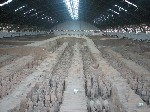
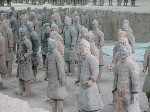 We decided to visit the Terracotta Army, which dates from 210 BC. The army is a form of funerary art buried with the Emperor of Qin (Qin Shi Huang) in 209-210 BC. The army was discovered in the 1970’s by local farmers near Xi'an near the Mausoleum of the First Qin Emperor. Current estimates are that in the three pits containing the Terracotta Army there were over 6,000 soldiers, 130 chariots with 520 horses and 150 cavalry horses, the majority of which are still buried in the pits.
We decided to visit the Terracotta Army, which dates from 210 BC. The army is a form of funerary art buried with the Emperor of Qin (Qin Shi Huang) in 209-210 BC. The army was discovered in the 1970’s by local farmers near Xi'an near the Mausoleum of the First Qin Emperor. Current estimates are that in the three pits containing the Terracotta Army there were over 6,000 soldiers, 130 chariots with 520 horses and 150 cavalry horses, the majority of which are still buried in the pits.
|
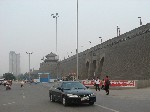 The big question was how to get there. The army is about 20 miles east of Xi’an and our options were an all day tour bus (240 rmb or $35.14), a taxi (66 rmb or $9.66), or a city bus (16 rmb or $2.40). Being world-traveling scientists/adventurers (and not because we’re cheap), we opted for the city bus as it was a good way to learn how the average Chinese gets around. We had to change buses at the railway station which is just outside the old city wall. The wall was build during the Ming Dynasty (1370). It is the most intact city wall in the world.
The big question was how to get there. The army is about 20 miles east of Xi’an and our options were an all day tour bus (240 rmb or $35.14), a taxi (66 rmb or $9.66), or a city bus (16 rmb or $2.40). Being world-traveling scientists/adventurers (and not because we’re cheap), we opted for the city bus as it was a good way to learn how the average Chinese gets around. We had to change buses at the railway station which is just outside the old city wall. The wall was build during the Ming Dynasty (1370). It is the most intact city wall in the world.
|
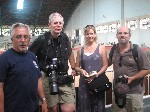
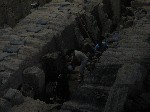 While at the Terracotta Army we ran into Fred Espenak again. Small world. We also saw some archeologists working in the pits unearthing more statues.
While at the Terracotta Army we ran into Fred Espenak again. Small world. We also saw some archeologists working in the pits unearthing more statues.
|
 Along the drive we passed by this pyramid and sphinx. I have no idea what it is for though.
Along the drive we passed by this pyramid and sphinx. I have no idea what it is for though.
|
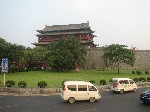 Here is a picture of the Bell Tower at the geographical center of Xian.
Here is a picture of the Bell Tower at the geographical center of Xian.
|
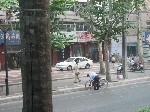 Finally, traffic here is insane. If you are a pedestrian you take your life in your hands every time you “try” to cross a street. Because, you see for drivers, a green light means go in all and any direction, while a red light means it’s OK to barrel through intersections when making a right turn (no need to stop). So what it comes down to, is when the light turns green for pedestrians to cross, you scatter to make it more difficult for cars to hit you. And don’t think that you’re safe once you make it to the sidewalk, as here in China, sidewalks aren’t just for pedestrians any more.
Finally, traffic here is insane. If you are a pedestrian you take your life in your hands every time you “try” to cross a street. Because, you see for drivers, a green light means go in all and any direction, while a red light means it’s OK to barrel through intersections when making a right turn (no need to stop). So what it comes down to, is when the light turns green for pedestrians to cross, you scatter to make it more difficult for cars to hit you. And don’t think that you’re safe once you make it to the sidewalk, as here in China, sidewalks aren’t just for pedestrians any more.
|

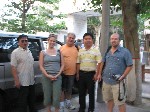 Because the pollution is so bad here in Xi’an, we are concerned that it will degrade the webcast, so our chore for the day was to rent a car, driver, and translator and go to Weinan to see what is available there. We meet with Rick Brown around 11:00 and headed towards Weinan (about 39 miles north-east of Xi’an and at a higher elevation). Once we got to Weinan we noticed that he air was much clearer, so we checked out a hotel that was recommended. The view from the roof was great however they could not rent to foreigners. So we tried another hotel that could rent a room to foreigners. However, they said that they were booked. So we tried the other hotel that could rent to foreigners (there’s only 2 hotels that can rent to foreigners in Weinan – a small town of only 500 thousand!). However, they could not allow us on the roof as there was a broadcast tower up there. OK plan B. We called the local TV station to see if they were interested in our webcast and the local newspaper. The newspaper (Weinan Daily News) was very interested and even got us 3 rooms (at a great rate) at the hotel that was “full”. The newspaper even has an intern who wants to help out (and practice her English). All we have to do now is find a 60 foot extension cord (not easy to do here). Regarding the photos: here we are at the newspaper’s office trying to work out details and here is today’s “crew” (from the left: driver, Tricia, Rick, Albert [our translator], and Tim). From Weinan we headed back to Xi’an for dinner and to call it a day.
Because the pollution is so bad here in Xi’an, we are concerned that it will degrade the webcast, so our chore for the day was to rent a car, driver, and translator and go to Weinan to see what is available there. We meet with Rick Brown around 11:00 and headed towards Weinan (about 39 miles north-east of Xi’an and at a higher elevation). Once we got to Weinan we noticed that he air was much clearer, so we checked out a hotel that was recommended. The view from the roof was great however they could not rent to foreigners. So we tried another hotel that could rent a room to foreigners. However, they said that they were booked. So we tried the other hotel that could rent to foreigners (there’s only 2 hotels that can rent to foreigners in Weinan – a small town of only 500 thousand!). However, they could not allow us on the roof as there was a broadcast tower up there. OK plan B. We called the local TV station to see if they were interested in our webcast and the local newspaper. The newspaper (Weinan Daily News) was very interested and even got us 3 rooms (at a great rate) at the hotel that was “full”. The newspaper even has an intern who wants to help out (and practice her English). All we have to do now is find a 60 foot extension cord (not easy to do here). Regarding the photos: here we are at the newspaper’s office trying to work out details and here is today’s “crew” (from the left: driver, Tricia, Rick, Albert [our translator], and Tim). From Weinan we headed back to Xi’an for dinner and to call it a day.
|
|
We checked out our hotel in Xi’an and headed towards the Guangming hotel in Weinan. Once in Weinan we meet with the Weinan Daily News intern (Fei Lei or "Condi") and took a taxi to the local train station to book passage to Quilin on Saturday. We ended up with regular seats for the 22 hour trip as no others (ie cabins with beds) were available. Ugh, I have read horror stories about traveling in “Hard Seats” in China, I hope they are exaggerations! We then went to a local market and found the extension cords required for this location (ours are not long enough). Our next major chore is to book passage from Quilin back to Beijing. To conclude, we really didn’t accomplish much today. But, some days are like that.
|
|
For dinner Condi took us to a local “hot pot” place. It was very good and very spicy (hot). We used up a lot of beer washing down the massive amount of food we ordered. Also, it appears that Weinan does not get a lot of visiting Caucasians as everyone stared at us and little kids and young girls all said “hello” (probably to hear our version of “hello”).
|
|
Today is the “big day”. The weather was looking iffy due to cloud cover, but there was a chance it would move on. Also, the network was not living up to it’s potential and I was up late last night and early today trying to figure out what level of quality we could webcast.
|
|
For lunch, Rick, Tim, and I went to a local restaurant and had Peking Duck (again). The waitresses were constantly at our table preparing the duck and helping, so we decided to leave them a tip (unheard of in China). We gave our waitress money for the bill including the extra money for a tip. She then counted it and tried to give the tip back. We motioned no, so she took the money to the cashier, paid our bill for us, and brought the tip back to us. Rick gave the waitress the tip again and she actually put the money back in his shirt pocket. So Tim and I left the restaurant and Rick dropped the money over the counter and we took off running. The waitress tried to chase us down, but we were too fast for her.
|
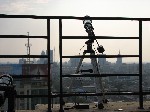
 Time for the big event. We hauled everything to the roof of the Guangming hotel and setup. I must add that the staff at the Guangming hotel were very helpfull and the rooms were nice. If you ever travel to Weinan, I suggest the Guangming hotel.
Time for the big event. We hauled everything to the roof of the Guangming hotel and setup. I must add that the staff at the Guangming hotel were very helpfull and the rooms were nice. If you ever travel to Weinan, I suggest the Guangming hotel.
|
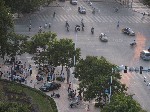
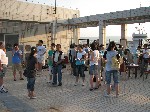 Then the people started to gather on street corners and the press gathered with us on the roof.
Then the people started to gather on street corners and the press gathered with us on the roof.
|
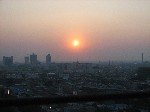
 And this is what it is all about.
And this is what it is all about.
|
 Here we are after a frustrating day. While the weather cleared and the eclipse went well we had lots of technical problems that prevented use from producing a “perfect” webcast (never mind me – I’m a perfectionist). But the viewers (US, Hong Kong, Slovinia, Greece, Poland, Australia, etc) seemed happy with our webcast and that is what matters. Finally, I think I know what it’s like to be hounded by the paparazzi. The local press and others who were on the roof wanted picture after picture. I feel lucky that we leave tomorrow before the TV story about us and the eclipse airs. Otherwise, it would be nearly impossible to leave the hotel (with all of those adoring fans probably wanting autographs – ha).
Here we are after a frustrating day. While the weather cleared and the eclipse went well we had lots of technical problems that prevented use from producing a “perfect” webcast (never mind me – I’m a perfectionist). But the viewers (US, Hong Kong, Slovinia, Greece, Poland, Australia, etc) seemed happy with our webcast and that is what matters. Finally, I think I know what it’s like to be hounded by the paparazzi. The local press and others who were on the roof wanted picture after picture. I feel lucky that we leave tomorrow before the TV story about us and the eclipse airs. Otherwise, it would be nearly impossible to leave the hotel (with all of those adoring fans probably wanting autographs – ha).
|
|
We got up this morning, had breakfast and started our desperate search for a better mode of transportation back to Beijing. We tried to get “soft sleeper” (a compartment with 4 beds) or at least “soft seats” (airline style seats with limited ticketing) for the train, but everything but the “hard seats” were sold out. The thought of 26 more hours in that class was too much to handle, so we fought with the Air China website and managed to get plane tickets.
|
|
We also booked a tour down the Li jiang river to see the mountainous formations (ie like the pictures in every Chinese restaurant in the U.S). We have also tentatively booked tours to see Longshang with its famous Longji rice terraces, and the area caves.
|
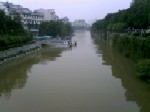
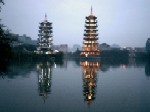 After dinner we walked through the city center, through a park where there are twin Pagodas in Downtown Guilin, and to the Something of Ethical theatrical dance and music performance. The show tries to recreate the culture of the various ethnic groups around Guilin. It was pretty good.
After dinner we walked through the city center, through a park where there are twin Pagodas in Downtown Guilin, and to the Something of Ethical theatrical dance and music performance. The show tries to recreate the culture of the various ethnic groups around Guilin. It was pretty good.
|
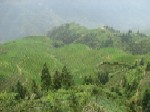
 Today we took a tour to the Longji area to see the mountain terraces and the local people. It’s pretty amazing how they carved the hills into terraces to grow crops.
Today we took a tour to the Longji area to see the mountain terraces and the local people. It’s pretty amazing how they carved the hills into terraces to grow crops.
|
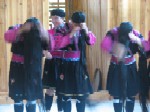
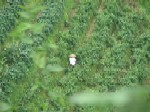 The local women never cut their hair and it can get several meters long. Also here is a “pepper picker” (Peter Piper?) working in his field/terrace.
The local women never cut their hair and it can get several meters long. Also here is a “pepper picker” (Peter Piper?) working in his field/terrace.
|
|
|
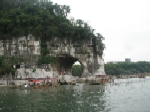
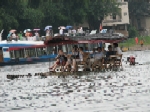 We took another boat tour of “Elephant Rock” in Guilin. Here is “Elephant Rock” and a bamboo boat like ours.
We took another boat tour of “Elephant Rock” in Guilin. Here is “Elephant Rock” and a bamboo boat like ours.
|
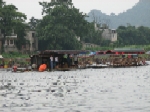
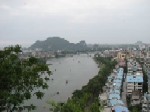 Many people appear to live on or near the river and here is a little food shop/snack bar on the river and a view of the river from the top of “Elephant Rock”.
Many people appear to live on or near the river and here is a little food shop/snack bar on the river and a view of the river from the top of “Elephant Rock”.
|
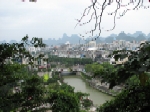
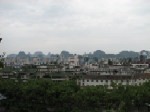 Here are two views of Guilin from “Elephant Rock”. Obviously the area is very pretty.
Here are two views of Guilin from “Elephant Rock”. Obviously the area is very pretty.
|

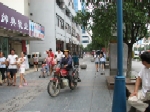 Here are two views of Guilin’s streets. I guess sidewalks aren’t just for pedestrians in many parts of China!
Here are two views of Guilin’s streets. I guess sidewalks aren’t just for pedestrians in many parts of China!
|
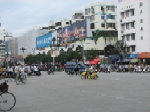
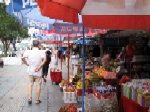 Here are more views of Guilin’s streets.
Here are more views of Guilin’s streets.
|
|
|
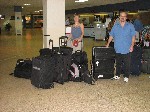 Another scientific adventure begins... Here we are at the Grand Forks, ND, USA airport packed to go. We will have to lug this mass throughout China for the next two weeks.
As you can see, putting on a webcast from the other side of the world is not easy! And, I should add, we have gotten very good at packing "light".
Another scientific adventure begins... Here we are at the Grand Forks, ND, USA airport packed to go. We will have to lug this mass throughout China for the next two weeks.
As you can see, putting on a webcast from the other side of the world is not easy! And, I should add, we have gotten very good at packing "light".










